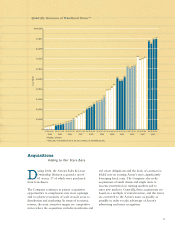Aarons 2004 Annual Report Download - page 21
Download and view the complete annual report
Please find page 21 of the 2004 Aarons annual report below. You can navigate through the pages in the report by either clicking on the pages listed below, or by using the keyword search tool below to find specific information within the annual report.
19
Franchise Guaranty. We have guaranteed the borrowings
of certain independent franchisees under a franchise loan
program with several banks. In the event these franchisees
are unable to meet their debt service payments or otherwise
experience an event of default, we would be unconditionally
liable for a portion of the outstanding balance of the fran-
chisee’s debt obligations, which would be due in full within
90 days of the event of default. At December 31, 2004, the
portion that we might be obligated to repay in the event
our franchisees defaulted was approximately $99.7 million.
However, due to franchisee borrowing limits, we believe
any losses associated with any defaults would be mitigated
through recovery of rental merchandise and other assets.
Since its inception, we have had no losses associated with
the franchisee loan and guaranty program
We have no long-term commitments to purchase merchan-
dise. See Note F to the Consolidated Financial Statements for
further information. The following table shows our approxi-
mate contractual obligations and commitments to make
future payments as of December 31, 2004:
Period Period Period Period
Less Than 2–3 4–5 Over
(In Thousands) Total 1 Year Years Years 5 Years
Credit Facilities,
Excluding Capital
Leases $ 98,862 $ 10,004 $ 65,537 $20,011 $ 3,310
Capital Leases 17,793 587 1,397 1,908 13,901
Operating Leases 175,777 50,676 70,483 31,069 23,549
Total Contractual
Cash
Obligations $292,432$ 61,267 $137,417 $52,988 $40,760
The following table shows the Company’s approximate
commercial commitments as of December 31, 2004:
Period Period Period Period
Less Than 2–3 4–5 Over
(In Thousands) Total 1 Year Years Years 5 Years
Guaranteed
Borrowings of
Franchisees $ 99,706 $99,706 $ —$—$—
Residual Value
Guarantee Under
Operating Leases 21,149 21,149
Total Commercial
Commitments $120,855 $99,706 $21,149 $ —$—
Purchase orders or contracts for the purchase of rental
merchandise and other goods and services are not included in
the table above. We are not able to determine the aggregate
amount of such purchase orders that represent contractual
obligations, as purchase orders may represent authorizations
to purchase rather than binding agreements. Our purchase
orders are based on our current distribution needs and are
fulfilled by our vendors within short time horizons. We do
not have significant agreements for the purchase of rental
merchandise or other goods specifying minimum quantities
or set prices that exceed our expected requirements for
three months.
Income Taxes. Within the next 12 months, we anticipate
that we will make cash payments for income taxes approxi-
mating $58 million.
Market Risk
We manage our exposure to changes in short-term
interest rates, particularly to reduce the impact on our
variable payment construction and lease facility and floating-
rate borrowings, by entering into interest rate swap agree-
ments. These swap agreements involve the receipt of amounts
by us when floating rates exceed the fixed rates and the
payment of amounts by us to the counterparties when fixed
rates exceed the floating rates in the agreements over their
term. We accrue the differential we may pay or receive as
interest rates change, and recognize it as an adjustment to
the floating-rate interest expense related to our debt. The
counterparties to these contracts are high credit quality
commercial banks, which we believe largely minimizes
the risk of counterparty default.
At December 31, 2004 we had swap agreements with total
notional principal amounts of $20 million that effectively
fixed the interest rates on obligations in the notional amount
of $20 million of debt under our variable payment construc-
tion and lease facility at an average rate of 7.5% until June
2005. Since August 2002 fixed rate swap agreements in the
notional amount of $32 million were not being utilized as
a hedge of variable obligations, and accordingly, changes
in the valuation of such swap agreements were recorded
directly to earnings. These swaps expired during 2003. The
fair value of interest rate swap agreements was a liability of
approximately $0.3 million at December 31, 2004. A 1%
adverse change in interest rates on variable rate obligations
would not have a material adverse impact on the future
earnings and cash flows of the Company.
We do not use any market-risk-sensitive instruments
to hedge commodity, foreign currency, or risks other
than interest rate risk, and hold no market risk sensitive
instruments for trading or speculative purposes.
Recent Accounting Pronouncements
In June 2002 the Financial Accounting Standards
Board (FASB) issued SFAS No. 146, Accounting for Costs
Associated with Exit or Disposal Activities (SFAS No. 146)
which addresses financial accounting and reporting for
costs associated with exit or disposal activities and nullifies
Emerging Issues Task Force Issue No. 94-3, Liability
Recognition for Certain Employee Termination Benefits and
Other Costs to Exit an Activity (including Certain Costs
Incurred in a Restructuring). SFAS No. 146 requires that a
liability for costs associated with an exit or disposal activity
be recognized when the liability is incurred as opposed to the
date of an entity’s commitment to an exit plan. SFAS No.
146 also establishes fair value as the objective for initial
measurement of the liability. SFAS No. 146 is effective for
exit or disposal activities that are initiated after December
31, 2002. Adoption of SFAS No. 146 did not have a material
effect on the Company’s consolidated financial statements.
























